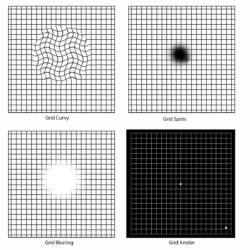
Macular degeneration is one of several eye diseases that lead to severe vision loss and blindness. Our board-certified ophthalmologists offer treatment for macular degeneration and discuss the five most commonly asked questions at our St. Joseph and Kansas City, Missouri offices.
1. Are Macular Degeneration and Glaucoma Related?
Macular degeneration causes damage to the center of the retina (the macula), in turn leading to central vision loss. In contrast, glaucoma, a group of eye diseases characterized by increased intraocular eye pressure, damages the optic nerve and affects side or peripheral vision first.
Both eye diseases lead to irreversible vision loss and have no known cure, but certain treatments and early diagnosis can slow disease progression. A 2017 study found people with macular degeneration who took medication to preserve their remaining eyesight may have a greater risk of glaucoma. Other research suggests a genetic link between glaucoma and macular degeneration. They can also coincide, stealing your central and side vision, but don’t affect each other’s progression.
2. Can Macular Degeneration be Prevented?
While the cause of macular degeneration is unknown, there are steps you can take to reduce your risk, including:
- Quit smoking
- Understand your family history of eye diseases
- Check for symptoms regularly if you have a genetic link
- Schedule annual eye exams to screen for macular degeneration
- Eat a diet heavy in leafy greens
- Take supplements, including a specialized blend that decreases the risk of severe macular degeneration called AREDS and AREDS 2
- Protect your eyes from sun exposure by using sunglasses with a UV 400 label
- Maintain a healthy weight and blood pressure
- Test yourself for macular degeneration at home with an Amsler grid
Macular degeneration is most common in those who are over 65 and/or Caucasian. It also affects more women than men.
3. Is Macular Degeneration Hereditary?
This eye disease appears to run in families, but you can still develop macular degeneration with no family history. Around 15 to 20 percent of patients with macular degeneration have a first-degree relative who also has the eye disease. If your sibling or parent has macular degeneration, you should be diligent about eye exams and testing at home with an Amsler grid. An Amsler grid is a sheet of paper with a grid of lines.
4. What Does Macular Degeneration Look Like?
 Macular degeneration damages your central vision. Someone with this condition may see a black or blurry spot in the middle of their field of vision. You can test for blank areas in your eyesight by looking at an Amsler grid. Someone with macular degeneration may see straight lines as wavy, misshapen or disconnected on the grid sheet.
Macular degeneration damages your central vision. Someone with this condition may see a black or blurry spot in the middle of their field of vision. You can test for blank areas in your eyesight by looking at an Amsler grid. Someone with macular degeneration may see straight lines as wavy, misshapen or disconnected on the grid sheet.
5. Can Macular Degeneration be Stopped?
Unfortunately, there’s no way to stop macular degeneration, but progression can be slowed, depending on the form. Dry age-related macular degeneration (AMD) develops slowly and damages the macula due to drusen deposits. Treatment for dry AMD include UV protection, quitting smoking, improving your diet and taking MacuTab vitamin supplements with six-month follow-ups at Wiles Eye Center. Wet AMD happens when abnormal blood vessels grow under or in the macula, leaking fluid and damaging tissues. Wet AMD causes rapid central vision loss, and immediate treatment is needed to save your vision with laser photocoagulation and Lucentis injections.
If you’ve been diagnosed with macular degeneration or are experiencing symptoms of central vision loss, macular degeneration nutritional supplements may help.
Contact our board-certified ophthalmologists at Wiles Eye Center to schedule your eye exam at our St. Joseph office at (816) 279-7015 or our Kansas City office at (816) 455-2020.

Comments are closed here.